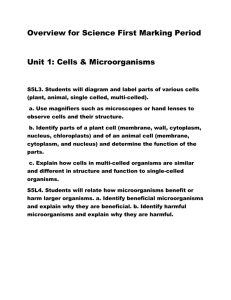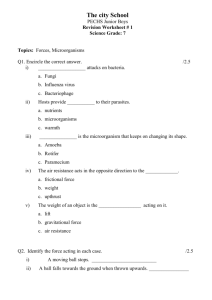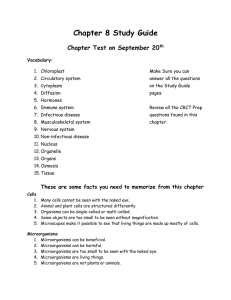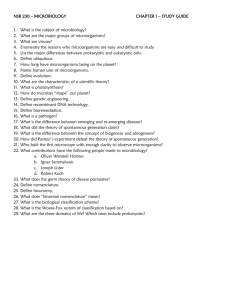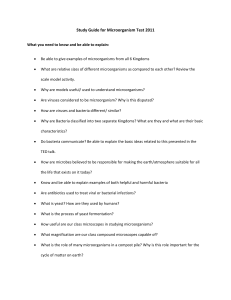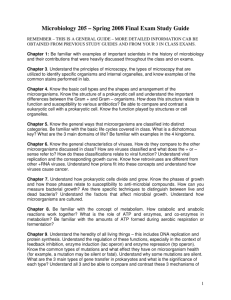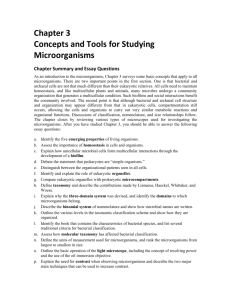Microbiology Ch 1 p3-10 [4-20
advertisement
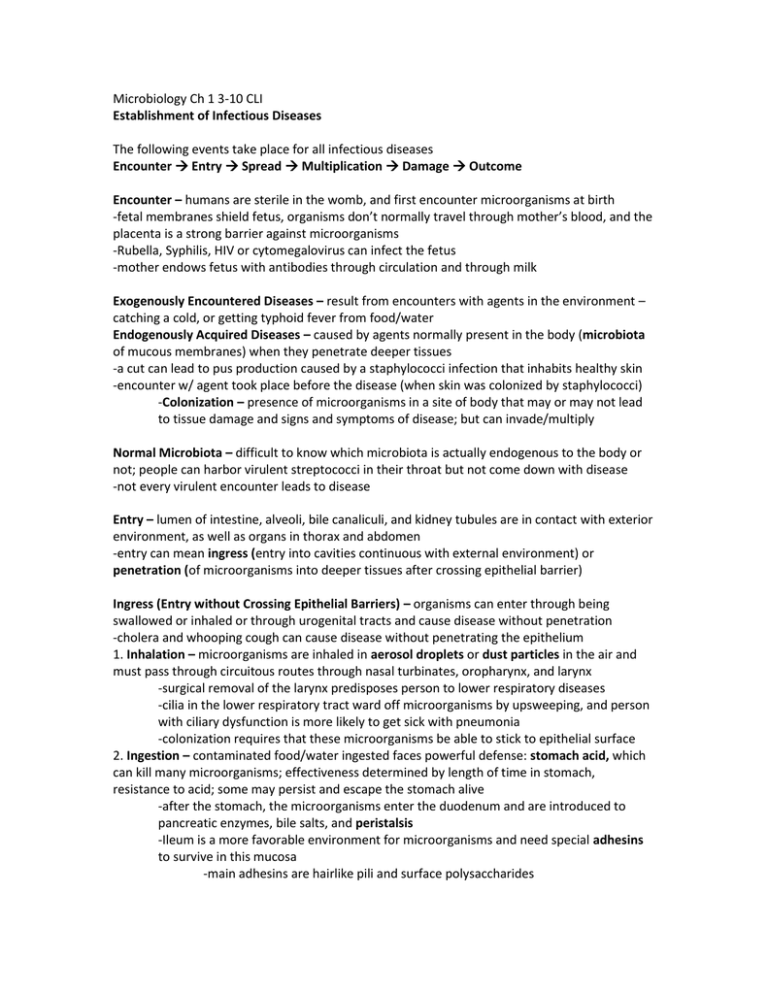
Microbiology Ch 1 3-10 CLI Establishment of Infectious Diseases The following events take place for all infectious diseases Encounter Entry Spread Multiplication Damage Outcome Encounter – humans are sterile in the womb, and first encounter microorganisms at birth -fetal membranes shield fetus, organisms don’t normally travel through mother’s blood, and the placenta is a strong barrier against microorganisms -Rubella, Syphilis, HIV or cytomegalovirus can infect the fetus -mother endows fetus with antibodies through circulation and through milk Exogenously Encountered Diseases – result from encounters with agents in the environment – catching a cold, or getting typhoid fever from food/water Endogenously Acquired Diseases – caused by agents normally present in the body (microbiota of mucous membranes) when they penetrate deeper tissues -a cut can lead to pus production caused by a staphylococci infection that inhabits healthy skin -encounter w/ agent took place before the disease (when skin was colonized by staphylococci) -Colonization – presence of microorganisms in a site of body that may or may not lead to tissue damage and signs and symptoms of disease; but can invade/multiply Normal Microbiota – difficult to know which microbiota is actually endogenous to the body or not; people can harbor virulent streptococci in their throat but not come down with disease -not every virulent encounter leads to disease Entry – lumen of intestine, alveoli, bile canaliculi, and kidney tubules are in contact with exterior environment, as well as organs in thorax and abdomen -entry can mean ingress (entry into cavities continuous with external environment) or penetration (of microorganisms into deeper tissues after crossing epithelial barrier) Ingress (Entry without Crossing Epithelial Barriers) – organisms can enter through being swallowed or inhaled or through urogenital tracts and cause disease without penetration -cholera and whooping cough can cause disease without penetrating the epithelium 1. Inhalation – microorganisms are inhaled in aerosol droplets or dust particles in the air and must pass through circuitous routes through nasal turbinates, oropharynx, and larynx -surgical removal of the larynx predisposes person to lower respiratory diseases -cilia in the lower respiratory tract ward off microorganisms by upsweeping, and person with ciliary dysfunction is more likely to get sick with pneumonia -colonization requires that these microorganisms be able to stick to epithelial surface 2. Ingestion – contaminated food/water ingested faces powerful defense: stomach acid, which can kill many microorganisms; effectiveness determined by length of time in stomach, resistance to acid; some may persist and escape the stomach alive -after the stomach, the microorganisms enter the duodenum and are introduced to pancreatic enzymes, bile salts, and peristalsis -Ileum is a more favorable environment for microorganisms and need special adhesins to survive in this mucosa -main adhesins are hairlike pili and surface polysaccharides -cholera and traveler’s diarrhea produce toxins in the intestine that affect epithelium and do not need to penetrate into deeper tissues Penetration (Entry into Tissues after Crossing Epithelial Barriers – some microorganisms pass directly through epithelia (where it is 1 layer thick), other pass through skin in the form of insect bites, and some worms can burry into the skin (hookworm) -to penetrate, most agents interact with receptors on the surface of host cell, such as influenza viruses containing surface components to bind receptors on sensitive host cells (attachment) which is followed by internalization -microorganisms can be carried into tissues by white cells or macrophages outside the body -alveolar macrophages (dust cells) – can carry inhaled infectious agents by phagocytosis, which can re-enter blood -cell-mediated entry can function in other mucous membranes such as HIV can penetrate from virus-laden macrophages from semen Insect Bites – can lead to penetration of viruses (viral encephalitis, yellow fever), bacteria (plague, typhus), protozoa (malaria, sleeping sickness), or worms (river blindness, elephantiasis) -for protozoa and worms, residence is part of normal life cycle -life stage of parasite in the insect is different from human host -reduviid bugs defecate at the same time they bite, and parasites in the feces enter by scratching the bite area (Chagas Disease is transmitted in this way) Cuts/Wounds – does not usually lead to symptoms of disease; things like brushing teeth can lead to abrasions through which organisms can enter the epithelium -organisms can enter blood, but are removed by lymphoreticular system -if systems are destroyed, things like subacute bacterial endocarditis can result, caused by oral streptococci invading heart valves damaged by previous disease (rheumatic fever) Organ Transplants – organ transplants and blood transfusions can cause infections to enter deeper tissues -cornea transplants can cause Creutzfeldt-Jakob Disease (CNS degenerative disease) -Kidney transplants can result in CMV infections -in organ transplants, host is usually immunosuppressed, and endogenous virus may begin to multiple and take advantage of weakened host -HIV and hepatitis B virus (HBV) can be transmitted through blood transfusions Inoculum Size – inoculum is the number of invading organisms, and can determine if an organism will result in infection -it takes many organisms to overcome local defenses, such as hot tub containing 100 million Pseudomonas bacteria, which can overcome skin defenses and infect host Spread – suggests direct, lateral propagation of organisms to contiguous tissues, and also dissemination to distant sites; organisms can only invade if they overcome host defenses -spread can precede OR follow microbial multiplication -malaria enters body through mosquito bite and is distributed throughout bloodstream before reproducing -for every host defense mechanisms, microbes have developed a strategy to overcome it, and the host adapts; host can win out, parasite overcomes the host, or they learn to live together Anatomical Factors – spread of microorganisms dictated by anatomical factors; such as the lung -in the lung, a bacterial abscess can burst and allow organisms to escape bronchial tree OR, if pointed outward, to the pleural cavity -if escaping the bronchial tree, it could lead to generalized pneumonia and if pointed outward, can lead to pleurisy -spread of microorganisms is influenced by fluid dynamics; infected fluids in the interior of the body tend to flow along fascial planes -infection on one site of meninges results in general meningitis because there are no barriers; same with pleura, pericardium, and synovial cavities Active Participation by Microbes – some microorganisms contribute to spread by moving either in random directions or in response to chemotactic signals -can be chemical in addition to mechanical; streptococci create hydrolases to break out of walled defenses, such as a protease to break fibrin, a hyaluronidase to break connective tissue and allow spread, and deoxyribonuclease to reduce viscosity of pus created by release of DNA from lysed white cells -fungi can secrete keratin-hydrolyzing enzymes to help them spread horny layers of skin Multiplication – disease is rarely caused without multiplication to increase the inoculum size -exception is for bacteria that produce a toxin, such as Clostridium botulinum which produces the botulinum toxin to lead to intoxication, NOT infection -in most infections, symptoms arise after an incubation period that is needed for infectious agents to overcome host defenses and grow to a certain population size Environmental Factors Influencing Multiplication – temperature, osmotic pressure, and pH influence multiplication, and many have a narrow temperature optimum -Pseudomonas can grow in lower temperatures as well -replication of poliovirus is limited to a few degrees over normal human body temp -fever can be a defense mechanism to help restrict the disease -fungi that cause athlete’s foot do not grow well above 30degrees Subversion of Host Defenses – each species of agents develop unique survival strategies -two types of strategies exist eliminating microbes: complement and phagocytosis, which make up humoral and cellular immunity -some microbes create a protective covering to block recognition and binding of complement and prevent phagocytosis by leukocytes (pneumococcus or meningococcus) -the capsules themselves are immunogenic and can be used for vaccine production -bacteria, such as gonococci or salmonellae can alter their surface antigens to avoid immunity -many organisms survive because they do not cause much damage to the host -the best adapted cause no disease, no inflammation, and help the host by providing -nutrients in the GI tract (vitamin B12) or crowding out potential pathogens -most successful pathogens are the sexually transmitted diseases Damage – damage is not always caused by activities of invading agent alone, but is often the consequence of a poor host response against the agent Mechanisms of Direct Damage – some bacteria produce toxins that are directly responsible for tissue damage, such as those of botulism and tetanus, which cause damage by helping bacteria spread, lyse host tissues, stop cell growth, or exaggerate normal physiological mechanisms -most dramatic manifestation of damage is cell death, which can come about through activation of cell-killing WBCs, or induction of apoptosis, and is serious if in essential organs (brain/heart) -many common gram-negative bacteria elicit host response through endotoxin, a surface lipopolysaccharide, which can elicit fever, mobilize host defenses, and cause shock/intravascular coagulation Immune Response – immune response can go awry and cause damage -Innate immunity – mechanisms always present and ready; less specific but require no previous exposure to a pathogen to become active; FIRST line of defense against invasion -Adaptive Immunity – classified as humoral if antibodies involved or cellular if the immune cells are involved Humoral Immunity – infecting agents elicit formation of antibodies, which combine with antigens in complexes that can activate an inflammatory response by facilitating activation of complement system through the classical pathway -complement can also be activated by the alternative pathway, which is by microorganisms alone (without antibodies) -products of complement cleavage work on platelets and WBC to increase vascular permeability and vasodilation, resulting in edema -other complement proteins act on WBC (chemotaxins) to make phagocytosis easier -antigen-antibody complexes are sometimes deposited in kidneys to impair function, called glomerulonephritis and is seen after some streptococcal and viral infections Cellular Immunity – leads to activation of macrophages to phagocytize later stages of inflammation and to clean up debris and remaining microorganisms -cell-mediated immunity is associated with chronic inflammation, the histologic changes that limit spread of infections, and also lesions in tissues -associated with chronic infections, such as chronic tuberculosis in which main damage to tissue is caused by cell-mediated immunity -immune response is elicited by tubercle bacilli, which persist in cells, leading to tubercles and granulomas and then tissue destruction Outcome – no infectious disease is simple, and humans have thousands of pathogens
